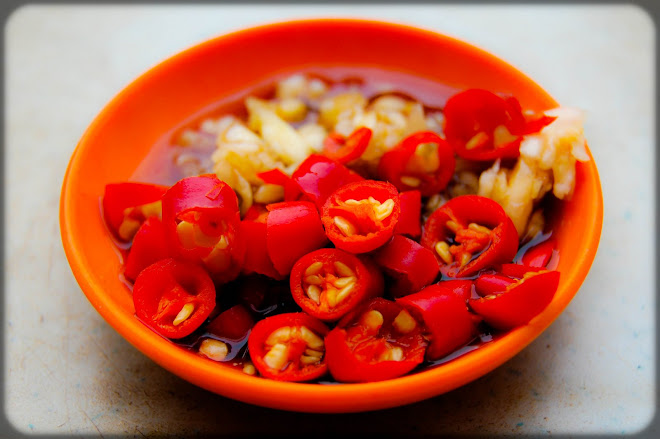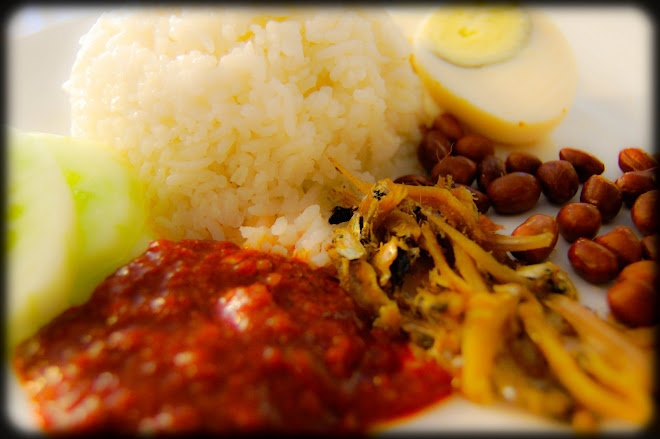27.jpg) What can a padi field be associated with? Padi, of course. Besides that, there's the mud that helps to contain water so that the padi can obtain nourishment from its roots. Then, there's the rustling of the padi stalks as the breeze coazes it to gently sway left and right like dancing to the rhythm of music. The beating of the padi stalk against the wooden drums as the farmers attempt to separate the rice from the stalks. Rump! Rump! Rump! The farmers seem to be lost in their own pace as each other compete to complete their tasks before the sun sets, with the sun's rays beating on their well worn bodies.
What can a padi field be associated with? Padi, of course. Besides that, there's the mud that helps to contain water so that the padi can obtain nourishment from its roots. Then, there's the rustling of the padi stalks as the breeze coazes it to gently sway left and right like dancing to the rhythm of music. The beating of the padi stalk against the wooden drums as the farmers attempt to separate the rice from the stalks. Rump! Rump! Rump! The farmers seem to be lost in their own pace as each other compete to complete their tasks before the sun sets, with the sun's rays beating on their well worn bodies.Ladies in straw hats bent down as they plant the padi using the traditional 'kuku kambing' to ease each stalk into the mud in a systematic manner and in neat rows. This has since been replaced with the mechanisation of the padi planting process, with the machines being towed by tractors as the machine steadily and quickly inserts the padi into the soil. Productivity increases as the farmers are now able to cover a much larger area since the padi planting process has been speeded up significantly.
25.jpg)
The padi will be left to mature over the next 6 months or so. With plenty of water around, fishes begin their life in the padi field as thousands of eggs hatch over time. Catching fish is sport in the padi field with the 'keli' variety outsurviving the other fishes as the fields dry up over time as the padi matures. Catch a few and place them in our little aquarium as we watch them with excitement over our catch. It won't survive long in this environment because it's habitat is in the muddy padi field.
Being bitten by leeches is also another aspect of fun in the padi field, as we traverse along the raised bunds that separates each padi plot in our endeavour to catch fish. The leech sticks to our legs, increases its grip on our skin as it attempts to suck my blood. A dash of salt would save the day, as it falls off onto the ground due to its adverse reaction to the salinity of the salt. Out comes my magnifying glass as I concentrate the sun's rays onto the leach, to see how much it can tolerate before burning up. Yes, that cruel I am and leeches are not the only objects that get burned under my magnifying glass.
As the padi matures, the whole padi field will be painted by golden yellow hues. The much stiffer stalks that has aged, will give out a soothing rustling sound as it sways in the wind. Images of kite flying now floods the memories as I recall my growing up years with the padi field in front of my house. No, I don't own the padi field. It's someone else's. After the rice has been collected and the dried stalks accumulated in heaps all over the dried padi field, I prepare my eagle shaped fabric kite ready to fly it. My brothers would take turns to run in a few attempts to launch the kite up into the sky. Then, the eagle kite will soar in the wind as it pretends to be a real eagle.
48.jpg)
These are my memories of the padi field that has since been replaced with a housing development project. I am a kampung boy at heart and it pains me to see the padi fields slowly being replaced with houses. No doubt, we need more houses as the population grows but couldn't they be sited somewhere else? The padi field was on prime land, therefore it had to make way. In a year's time, I can only expect to see houses where the padi field used to be, in front of my house. I only have a few photographs to remind me of how it used to look like. Film being expensive to develop and print in those days, these few photographs are the only proof of the legacy of the space in front of my house. I will now retreat to dreamland... as I recall my adventures in the padi field as I was growing up.





